
| Go to Allan's Page | Our Home Page | Holidays Home Page | British Canals Page | Go to Deb's Page |
| Part 1: Lisbon and Porto | FlickR album of these photos | Part 2: Up the Douro River |
Leaving the River and the wineries behind us for the afternoon, we boarded the coach for a visit to the ancient city of Castelo Rodrigo. Originally built by the Romans but fortified at the beginning of the 13th century, it is set high on a hilltop. With its superb view across the plains it was easily defended against attack, but it frequently changed its nationality as the Spanish/Portuguese border moved back and forth (as did our mobile phones, as we drove near the border, which was particularly confusing because Spain and Portugal are in different time zones). Castelo Rodrigo was always a multicultural city, providing a co-operative environment for Jews, Arabs, and Christians at the same time; indeed the Christians here provided safe haven for a large Jewish community during the Spanish Inquisition of the 16th century. The city itself is fascinating, with steep, narrow cobbled streets that seem to have been left unchanged by the passage of time. There are also a couple of souvenir shops, with a particularly fine range of items made from cork.
On our way back to the ship we paused to admire the spectacular scenery. The River Douro looked absolutely tiny from high up in the mountains, while vultures circled in front of us looking for their supper.
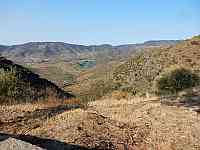 |
 |
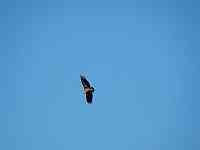 |
The Douro Valley, as seen from up in the mountains |
Can you spot the vulture? |
Got him! |
A full day's excursion followed, with a coach trip across the border into Spain, to visit the beautiful city of Salamanca with its amazing variety of ancient buildings. On the way we saw many storks' nests; it us illegal to damage these nests and as storks return to the same nests year after year and add a few twigs every time, many of these nests are extremely old and extremely heavy - such that the buildings may actually need to be strengthened to support them.
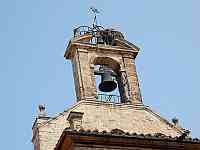 |
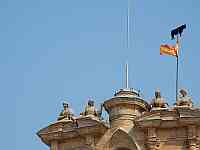 |
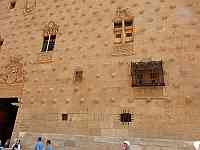 |
 |
A typical stork's nest |
A figure of a bull tops the flagpole |
This building is known as the House of Shells = for obvious reasons |
The incredible ceiling of the House of Shells |
Arriving in Salamanca, we first visited an indoor market where the most incredible arrays of cheeses, cured ham, and fresh seafood were on display. Naturally we were given a few samples to taste, with a drink or two to wash them down!
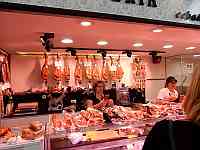 |
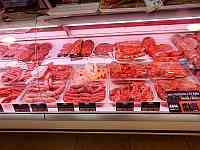 |
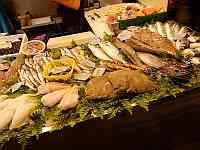 |
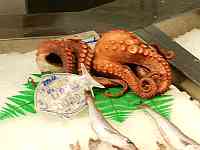 |
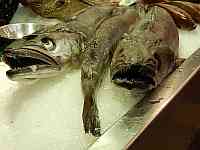 |
Salamanca is a city where once bull-fighting was extremely popular; evidence for this exists in a great many ways, including the image of a bull on top of many of the flagpoles (particularly around the bull-ring which, when we were there, was being prepared for a much more civilised activity, namely a grand concert), and also a great deal of ancient graffiti which had been painted on the old university walls in bull's blood.
The emblem of the University, and hence of the city, is a frog on top of a human skull. We were told at least three "definitive" explanations of its meaning; I guess nobody really knows the answer but it has become traditional to search for this emblem carved into the facade of the old University building. It is very small and quite high up, so people usually have to spend a long time searching for it.
Other buildings had elaborate carvings on their facades too. For example the cathedral has elaborate carving around the doorway, which was renovated recently - with an additional detail to identify a new section: amongst the traditional emblems it now also depicts an astronaut.
It was not only Salamanca, however, where we found interesting carvings. At the small town of Lamego which we visited the following day, the Cathedral doorway included - amongst all the images of saints and religious symbols - a small carving of a man and a woman getting to know each other in a rather intimate way!
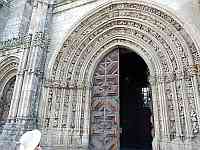 |
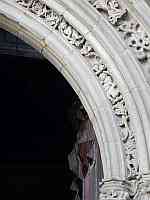 |
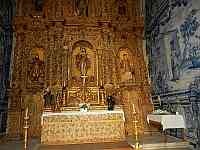 |
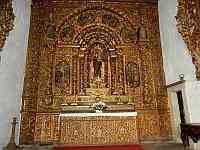 |
The doorway of Lamego Cathedral |
A rather 'interesting' image among the carving around the Cathedral doorway |
The opulence of the gilding in the side-chapels of Lamego Cathedral was breathtaking |
|
The town of Lamego is overlooked from on-high by the Shrine of Our Lady of Remedies. It is reached by an incredible stone stairway up the hillside (or in our case by motor-coach) and is visited by thousands of pilgrims every year, many of whom climb the stairway on their knees in the hope of having a miracle bestowed on them.
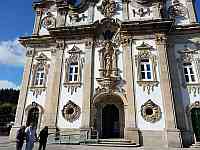 |
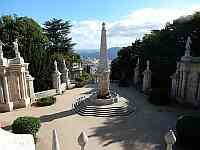 |
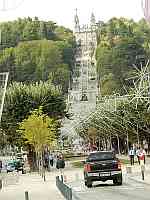 |
The Shrine of Our Lady of Redemption ... |
... overlooks the town of Lamego ... |
... from the top of a magnificent stone stairway |
We finally returned to the ship at Porto for one final night on board, having a magnificent farewell dinner and a few drinks with our friends, before reluctantly having to leave this beautiful country for the flight home.
| Part 1: Lisbon and Porto | FlickR album of these photos | Part 2: Up the Douro River | ||
| Go to Allan's Page | Our Home Page | Holidays Home Page | British Canals Page | Go to Deb's Page |
All pictures on this site are © Allan Jones unless otherwise stated